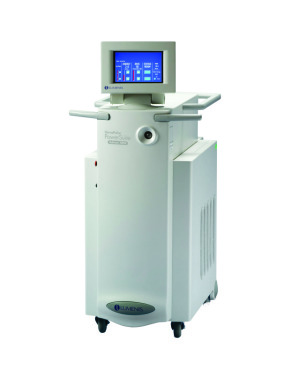by
Sean Ruck, Contributing Editor | March 28, 2014

Lumenis VersaPulse
PowerSuite 100W
From the March 2014 issue of HealthCare Business News magazine
A few key technologies in the surgical lasers sector are cutting out a niche in treating BPH, herniated discs and other sensitive treatments
If baseball great Yogi Berra was keeping up with strides forward in the surgical laser sector, he might just offer up his Yogiism, “It’s déjà vu all over again.” For those familiar with the sector, the case for that assessment is strong with technology first introduced decades ago now making the rounds and being all the rage among today’s medical professionals.
Laser technology’s first attempts at breaking into health care occurred in the early ‘80s with limited success. At the time, surgical laser technology was explored as an alternative to some long-established treatments in neurosurgery and urology.
However, due to the prohibitive cost attached to the technology, the additional training and education required in its use as well as less than optimal patient outcomes, it was shelved as a valid treatment option for some procedures.
Today, however, it’s a different ballgame and surgical lasers are being used more everyday with substantial data supporting their use.
Tried and true versus flashy and new for BPH
The traditional method for treating benign prostatic hyperplasia, an age-related enlargement of the prostate, is a transurethral resection of the prostate, or TURP. The procedure utilizes a resectoscope to remove prostate tissue. Although TURP has been the standard for about a century, it wasn’t a pleasant time for patients.
For starters, due to extensive blood loss that occurs during the procedure, individuals are ineligible for TURP if they have heart conditions or are on blood thinners. For those clearing that hurdle, the procedure also runs the risk of seriously diluting serum sodium, which can lead to seizures. Finally, the recovery time is slow, with patients kept in the hospital usually for one to two days, and usually having a catheter for an additional couple days. As with any procedure, the surgeon’s skill plays an important role in minimizing negative outcomes, but it’s not uncommon for issues to arise including incontinence and problems with sexual function.
Still, for 100 years, it was the best solution for most individuals with BPH. In the ‘80s, holmium lasers had already been used for some time to break up kidney stones. Naturally, manufacturers decided to explore other potential uses for laser technology. BPH was being treated by using a device to heat tissue and lasers could, in theory, generate heat in very precise areas — so the idea to use the technology to treat the condition made sense.
